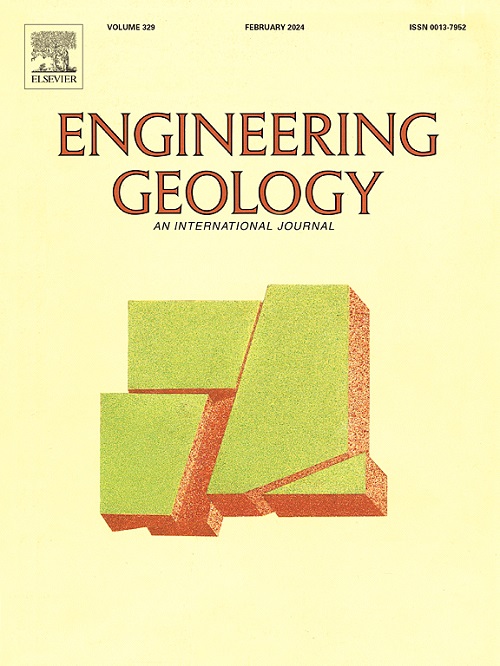热带气候条件下云母花岗岩残土的微观结构演化与力学退化研究
IF 6.9
1区 工程技术
Q1 ENGINEERING, GEOLOGICAL
引用次数: 0
摘要
云母残土(MRS)是热带地区常见的一种边缘岩土材料,由于预算限制,在低品位的建设项目中经常使用。然而,目前对其岩土力学特性,特别是其长期环境响应和微观结构变化知之甚少。本文研究了云母含量和气候引起的干湿循环对MRS物理力学性能的影响。通过将白云母粉与平原残土混合,去除原始云母,制备了具有不同云母含量的MRS样品。这些样品经受了WD循环模拟热带气候条件。通过系统的试验试验和细观观察,分析了土工性能和细观结构的变化。在WD循环中观察到的降解包括裂纹扩展、体积膨胀、强度降低和崩解增加,所有这些都与云母含量呈正相关。值得注意的是,对于云母含量高的MRS, WD循环改善了土壤的脆性,改变了以前认为MRS的性能都很低的看法。云母在长期环境变化下对MRS的影响归因于云母的固有特性和土壤中的颗粒堆积结构。本研究提高了对热带气候条件下MRS特性的认识,为进一步改进和有效利用这种边缘材料提供了技术建议。本文章由计算机程序翻译,如有差异,请以英文原文为准。
Decoding microstructural evolution and mechanical degradation of micaceous granite residual soils as marginal geomaterials in tropical climates
Micaceous residual soil (MRS), a marginal geomaterial commonly found in tropical regions, is often used in low-grade construction projects due to budget constraints. However, little is currently known about its geotechnical properties, especially its long-term environmental response and microstructural variations. Investigated here is how mica content and climate-induced wetting–drying (WD) cycles affect the physical and mechanical properties of MRS. Reconstituted MRS samples with varying mica contents were prepared by mixing muscovite powder with plain residual soil, from which the original mica was removed. These samples were subjected to WD cycles to simulate tropical climate conditions. Geotechnical properties and microstructural changes were analyzed through systematic experimental tests and microscopic observations. The degradation observed during the WD cycles included crack propagation, volumetric swelling, reduced strength, and increased disintegration, all of which were positively correlated with mica content. Notably, for MRS with high mica content, the WD cycles ameliorated the soil brittleness, altering previous perceptions of uniformly low performance for MRS. The effect of mica on MRS under long-term environmental changes is attributed to both the inherent properties of mica and the particle packing structure in the soil. This study enhances the understanding of MRS behavior in tropical climate and provides technical recommendations for further improvement and effective application of this marginal geomaterial.
求助全文
通过发布文献求助,成功后即可免费获取论文全文。
去求助
来源期刊

Engineering Geology
地学-地球科学综合
CiteScore
13.70
自引率
12.20%
发文量
327
审稿时长
5.6 months
期刊介绍:
Engineering Geology, an international interdisciplinary journal, serves as a bridge between earth sciences and engineering, focusing on geological and geotechnical engineering. It welcomes studies with relevance to engineering, environmental concerns, and safety, catering to engineering geologists with backgrounds in geology or civil/mining engineering. Topics include applied geomorphology, structural geology, geophysics, geochemistry, environmental geology, hydrogeology, land use planning, natural hazards, remote sensing, soil and rock mechanics, and applied geotechnical engineering. The journal provides a platform for research at the intersection of geology and engineering disciplines.
 求助内容:
求助内容: 应助结果提醒方式:
应助结果提醒方式:


